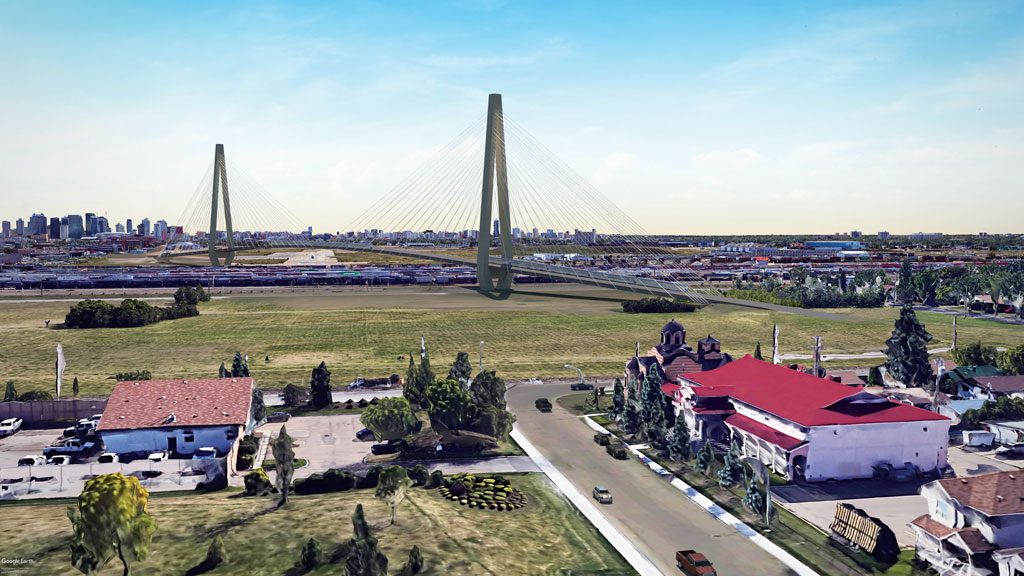Construction of a mammoth, $200-million cable-stayed bridge that would stretch across Yellowhead Trail in the north end of Edmonton has been unveiled as part of plans being considered by city council to extend the northwest leg of Edmonton’s light rail transit (LRT) system.
The bridge would be the first long-span cable-stayed bridge in the City of Edmonton, and Alberta, as well as the longest cable-stayed bridge span dedicated to LRT in North America.
The structure, with a total length of 726 metres including the approaches, would reshape Edmonton’s northern skyline and become a landmark of the city.
“One of the challenges in building a bridge like this is that none of the support pylons can be on the Yellowhead Trail or in the CN Rail Walker Yard, so that necessitates the long span and tall towers,” said Scott Macintosh, general supervisor, project management of Edmonton’s LRT infrastructure delivery.
There are many design challenges for a long-span bridge like the one proposed, he said, noting wind-sensitivity, rigidity and fatigue are the most significant.
“On one hand, long-span cable-stayed bridges are wind sensitive structures and are flexible by nature,” he said. “On the other hand, LRT bridges need to be rigid enough to ensure the safe operation of trains and to provide comfort to the pedestrians and the cyclists on the sidewalk under wind and other loads.”
The challenge then, he said, is to find a balanced point in the design to meet performance criteria and still have a constructible structure.
A cable-stayed bridge is a design that supports the deck with cables running directly to a tower.
This bridge would add a long-missing piece to the bridgescape in Alberta
— Scott Macintosh
City of Edmonton
Macintosh said a complicating factor in the build will be the fatigue challenge that arises from the LRT train load frequencies.
“Modern train schedules call for short intervals between trains. The trains themselves, even when empty, constitute a heavy load. The structure, especially the stay cables, is subjected to an extremely high number of load cycles.”
The proposed bridge is included in the second part of a two-phase proposal in Edmonton’s transportation master plan that is being considered by city council to carry the city’s Metro Line LRT extension north. The vision is to expand LRT services to all sectors of the city over the next two decades.
The first phase entails extending the LRT line to connect NAIT with a station on the Blatchford development site where a 20-year project is underway to build housing for 30,000 people.
The city is looking for funding from the federal and provincial governments to pay for that segment of the work and the procurement process on the first phase could begin in early 2019. The work would involve installing one kilometre of track and extending the line to where the bridge is to be built.
The second phase, which wouldn’t start for at least another five years, would entail extending the LRT another 10 kilometres to Campbell Road and building the bridge.
The design for the entire extension consists of 11 kilometres of trackway, including nine stations, two transit centres, an operations and maintenance facility, a light rail vehicle storage facility, and a park and ride.
Recommendations are being brought to Edmonton council Nov. 6 for approval. Cost of the second phase is between $1.8 and $2.2 billion, with the bridge price tag expected to be $150 to $200 million.
The structure will be a five-span, cable-stayed bridge with two pylons and two cable planes. It will have a main span length of 373 metres. The bridge will have both southbound and northbound LRT tracks and a shared-use path for pedestrians and cyclists. The diamond-shape pylons will be about eight storeys above the bridge deck.
The main span of the bridge would be constructed in a cantilevered way from the two pylons, and the two cantilevers will meet and be joined together at the mid-way point. This type of construction would require no access from the ground below, therefore minimizing the impact on the operation of the CN Rail Walker Yard facility.
Macintosh said the bridge will be unique because it will be one of the tallest and longest bridges in Edmonton.
The span between the two towers where it crosses the rail yard would be 400 metres. The city’s Walterdale Bridge, for example, could fit within the two 75-metre-tall towers on the proposed bridge.
Other long-span bridges in the province, such as the Valley Line LRT bridge over the North Saskatchewan River or Dunvegan Bridge over the Peace River, have cables as structural elements, but are either extradosed bridges or suspension bridges.
“This bridge would add a long-missing piece to the bridgescape in Alberta,” said Macintosh, noting it would feature a narrow deck width and relatively low profile with respect to vertical clearance. “It will enable a close-up view of a magnificent structure by an observer on the ground.”










Recent Comments